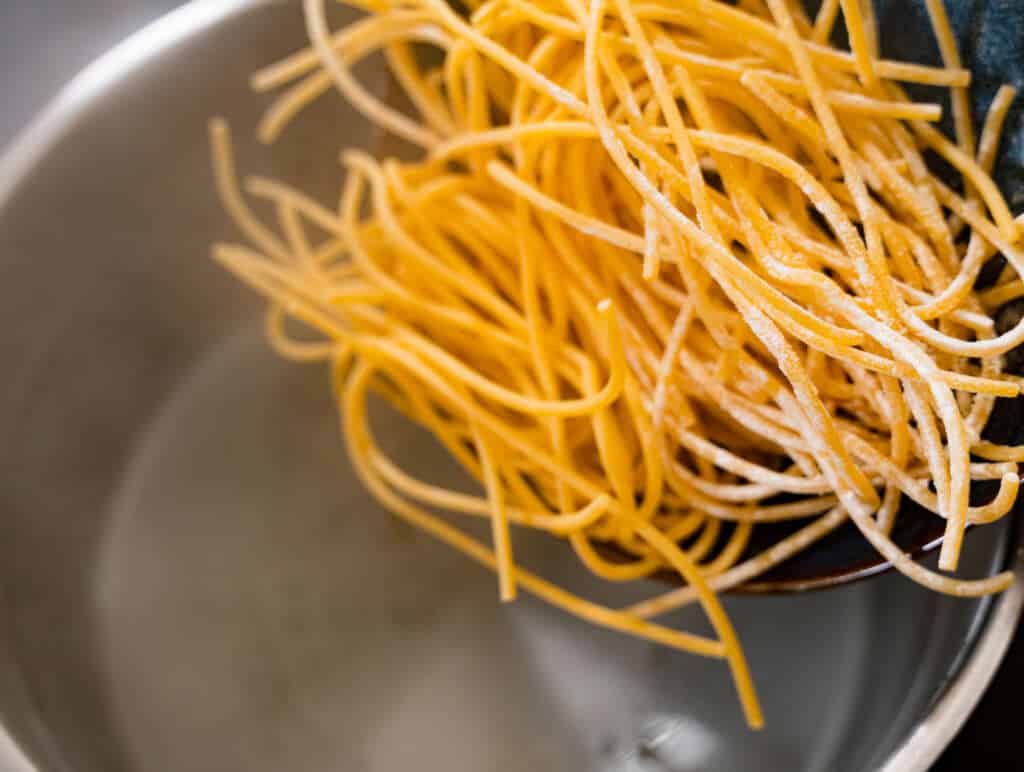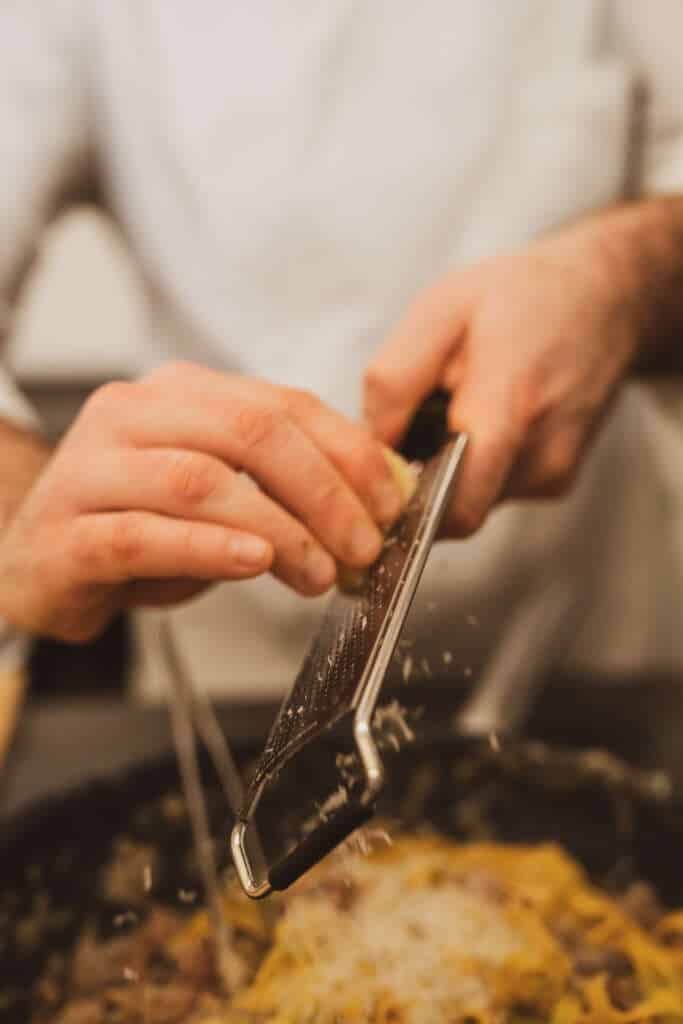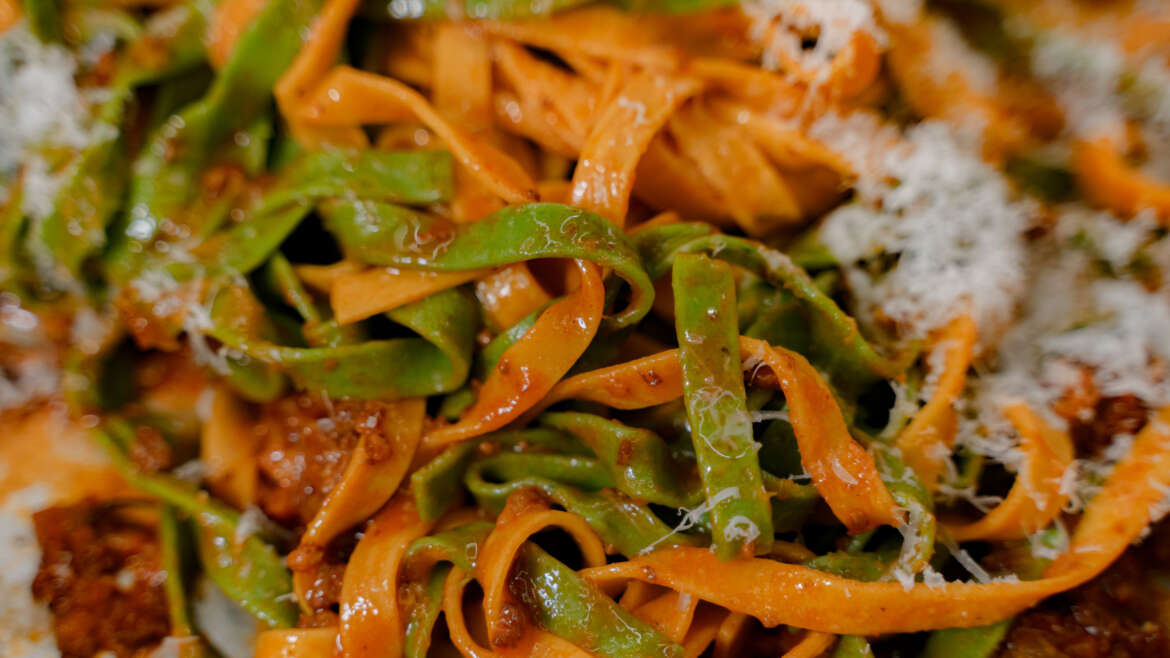Knowing how to cook pasta is a process that may seem deceptively simple but, in reality, requires attention and allows no distractions.
Pasta is a staple of Italian cuisine and is prepared daily because it is an affordable food that doesn’t require much time to create tasty dishes.
Cooking pasta to perfection is a technique that requires attention and allows no room for mistakes. Anyone who has spent even a short time with an Italian knows that preparing a plate of pasta for us is a sacred ritual. And woe to you if you break the spaghetti!
Pasta is an almost constant presence on Italian tables because it allows for the quick preparation of various, tasty dishes without spending too much. To create an excellent pasta dish, it’s not just about using quality ingredients but also knowing how to cook it as Italian tradition dictates, that is, “al dente”.
So, how do you cook it just right and achieve the perfect texture? Let’s find out together.
How to cook pasta: the process to avoid mistakes
Place the pot on the heat and wait for the water to boil to cook the pasta to achieve an al dente texture. Cover the pot with the appropriate lid to speed up the boiling process: this way, the water will boil faster, and consequently, you’ll also avoid wasting electricity or gas. Once the water has reached the boiling temperature, you can add salt, preferably coarse salt, in the right amount, based on either the amount of water used or the pasta.
The pasta should be dropped into the pot all at once, following certain techniques depending on the shape.
For example, bucatini and spaghetti should be grasped and inserted into the pot in a swirling motion: initially, the pasta will stand upright, but as seconds pass, it will tend to position itself inside the pot.
Regarding cooking times, it is necessary to follow the instructions on the packaging. A good suggestion is to set a timer and taste the pasta to achieve the desired consistency. During the cooking phase, it is important to stir often to prevent the pasta from sticking to the pot. Before draining the pasta to check if the desired “al dente” cooking is achieved, we suggest examining the so-called “soul of the pasta,” the white trace inside. If it appears too white, it means the pasta is still undercooked.
Once the pasta is perfectly cooked, it should be drained using oven gloves to handle the pot. Place a colander inside the sink, lower the pasta into it, and eliminate excess liquid. A useful tip is to reserve some cooking water, useful for diluting sauces and cleaning encrusted dishes.
We strongly advise against using oil or rinsing the pasta with cold water because this step makes the pasta sticky and unpleasant to eat.
After draining the pasta, you can place it back into the pot used for cooking and gradually add the sauce or seasoning evenly.
8 tips for cooking pasta perfectly
To cook pasta without mistakes, carefully follow these 8 simple steps that allow you, with little effort, to achieve excellent cooking results. From choosing the right pot, the amount of water to fill it, to cooking times, here are the steps to follow for success and to bring a delicious and pleasingly textured dish to the table.
1 Choose the right pot
To cook pasta, you need a pot that should be chosen considering the amount of water needed to fill it and the pasta format to be cooked.
For example, if you want to prepare a dish using short pasta, such as penne, it is advisable to choose a wide pot with low sides, while if you want to prepare spaghetti or bucatini, you will need a wide pot but with higher sides.
The size of the pot to use also depends on the number of diners.
2 Use just enough water
The ratio of water to pasta should be one liter of water for every 100 grams of pasta. Another suggestion is to never completely fill the pot, but only up to 2/3 of its capacity. It is also important to consider the size of the stove: a flame that is too small under a large pot would prevent the water from boiling quickly. Conversely, if a small pot is used on a large stove, the water could boil very quickly and overflow, dirtying the cooktop. To quickly boil water, a trick is to cover the pot with the lid: when you see steam escaping, it means the water is boiling.
3 Add coarse salt
Coarse salt should be added when the water is boiling because otherwise, it could corrode or damage the pot. But not only that. If added when the water is cold, it could even give a metallic taste to the pasta and delay the boiling of the water. The recommended amount of coarse salt to use should be 10 grams per liter of water or 7 grams per 100 grams of pasta. In any case, it is always better not to exaggerate, taste the pasta during cooking, and possibly add it gradually, adjusting it based on the sauce with which you will dress your pasta.
4 Lowering the Pasta

Once the water reaches a boil and you have added coarse salt, you can lower the pasta. The pasta should be lowered all at once to ensure a uniform cooking time for the entire quantity being prepared. At this point in the process, it’s essential to be a bit more attentive and carefully follow the cooking process.
The first suggestion is to stir the pasta every 2/3 minutes, preferably using a wooden spoon, to prevent sticking and to taste it.
Only in this way can you be certain if the desired cooking result has been achieved.
5 Check Cooking Times
The cooking times indicated on pasta packages must be strictly adhered to and vary depending on the format. For example, if you are cooking large and thick pasta, such as conchiglioni, it is advisable to check more carefully as they could easily break.
In this case, it’s better to taste them even 2/3 minutes before the indicated cooking time, which usually hovers around 8/9 minutes.
It’s a different story with thin pasta, like capelli d’angelo (angel hair), which cooks quickly.
A suggestion is to set a timer to remember when the cooking minutes have passed and to avoid constantly checking the pot.
6 Preserve the Cooking Water
Once the pasta is perfectly cooked and ready to be drained, we recommend preserving and setting aside about 200 ml of cooking water, which can be very useful.
To avoid scalding, we suggest using a ladle and placing the water in a cup. Why? With cooking water, you can not only dilute thick sauces when they are too dense but also deglaze dishes and clean the utensils used for cooking.
7 Drain the Pasta
To drain the pasta, wear an oven glove or a kitchen towel, grasp the pot by the handles, and place a colander in the sink. Pour the contents into the colander, allowing the cooking water to go down the sink, and gently shake it to remove excess liquid.
We suggest never adding oil and never cooling the pasta under cold water, unless you intend to prepare pasta salad.
8 Add the Sauce

The sauce or seasoning, in general, should be added when the pasta is still hot to mix it well. Once the pasta is drained, simply transfer it to the pot in which it was cooked and gradually add the sauce, stirring. For example, if a Bolognese sauce has been prepared, simply heat it and add the right amount to the cooked pasta with a ladle, ensuring even distribution.

